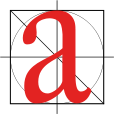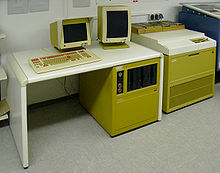- Phototypesetting
-
Part of a series on the History of printing 
Woodblock printing (200) Movable type (1040) Printing press (1454) Etching (ca. 1500) Mezzotint (1642) Aquatint (1768) Lithography (1796) Chromolithography (1837) Rotary press (1843) Offset printing (1875) Hectograph (19th century) Hot metal typesetting (1886) Mimeograph (1890) Screen printing (1907) Spirit duplicator (1923) Dye-sublimation (1957) Phototypesetting (1960s) Dot matrix printer (1964) Laser printing (1969) Thermal printing (ca. 1972) Inkjet printing (1976) Stereolithography (1986) Digital press (1993) 3D printing (ca. 2003) Phototypesetting was a method of setting type, rendered obsolete with the popularity of the personal computer and desktop publishing software, that uses a photographic process to generate columns of type on a scroll of photographic paper. Typesetters used a machine called a phototypesetter, which would quickly project light through a film negative image of an individual character in a font, through a lens that would magnify or reduce the size of the character onto film, which would collect on a spool in a light-tight canister. The film would then be fed into a processor, a machine that would pull the film through two or three baths of chemicals, where it would emerge ready for paste up.
Contents
History
Phototypesetting machines projected characters onto film for offset printing. This "cold type" technology could be used in office environments where "hot metal" machines (the Mergenthaler Linotype, the Harris Intertype and the Monotype) could not. The use of phototypesetting grew rapidly in the 1960s when software was developed to convert marked up copy, usually typed on paper tape, to the codes that controlled the phototypesetters. The Photon Corporation in Cambridge, Mass. developed equipment based on the Lumitype of Rene Higonnet and Louis Moyroud.[1] Mergenthaler produced the Linofilm using a different design and Monotype produced Monophoto. Other companies followed with products that included Alphatype and Varityper.
To provide much greater speeds, the Photon Corporation produced the ZIP 200 machine for the MEDLARS project of the National Library of Medicine and Mergenthaler produced the Linotron. The ZIP 200 could produce text at 600 characters per second using high speed flashes behind plates with images of the characters to be printed. Each character had a separate xenon flash constantly ready to fire. A separate system of optics positioned the image on the page.[2]
An enormous advance was made by the mid 1960s with the development of equipment that projected the characters onto CRT screens. Alphanumeric Corporation (later Autologic) produced the APS series. Rudolf Hell developed the Digiset machine in Germany. The RCA Graphic Systems Division manufactured this in the U.S. as the Videocomp, later marketed by Information International Inc.. Software for mechanical hyphenation was a major component of electronic typesetting. Early work on this topic produced paper tape to control hot metal machines. C. J. Duncan, at the University of Durham in England, was a pioneer. The earliest applications of computer controlled phototypesetting machines produced the output of the Russian translation programs of Gilbert King at the IBM Research Laboratories, and built-up mathematical formulas and other material in the Cooperative Computing Laboratory of Michael Barnett at MIT.
There are extensive accounts of the early applications,[3] the equipment[4][5] and the PAGE I algorithmic typesetting language for the Videocomp, that introduced elaborate formating[6]
In Europe, the company of Berthold had no experience in developing hot-metal typesetting equipment, but being one of the largest German type foundries, they knew everything about type.[citation needed] Berthold successfully developed its Diatype (1960), Diatronic (1967), and ADS (1977) machines, which led the European high-end typesetting market for decades.
Compugraphic produced phototypesetting machines in the 1970s made it economically feasible for a number of small publications to set their own type professionally. One model, the Compugraphic Compuwriter, used a filmstrip wrapped around a drum that rotated at several hundred revolutions per minute. The filmstrip contained two fonts (a Roman and a bold or a Roman and an italic) in one point size. To get different sized fonts, the typesetter loaded a different font strip or used a 2x magnifying lens built into the machine, which doubled the size of font. The CompuWriter II automated the lens switch and let the operator use multiple settings. Other manufacturers of photo compositing machines included Alphatype, Varityper, Mergenthaler, Autologic, Berthold, Dymo, Harris (formerly Linotype's competitor "Intertype"), Monotype, Star/Photon, Graphic Systems Inc., Hell AG, and MGD Graphic Systems, not to forget ATF's Phototypesetters model "A", "B" and "B-8".
In 1975, the Compuwriter IV, as well as the Compuwriter 88, a stripped down version, held two filmstrips, each holding four fonts. (Usually a Roman, italic, bold, and bold italic font). It also had a lens turret which had eight lenses giving different point sizes from the font, generally 8 or 12 sizes, depending on the model. The low-end offered sizes from 6 to 36 point, while the high-end models went to 72 point. The Compugraphic EditWriter series took the Compuwriter IV configuration and added floppy disk storage on an 8-inch, 320K disk. This allowed the typesetter to make changes and corrections without rekeying. A Cathode ray tube (CRT) screen let the user view typesetting codes and text.
Because early generations of phototypesetters couldn't change text size and font easily, many composing rooms and print shops had special machines designed to set display type or headlines. One such model was the PhotoTypositor, manufactured by Visual Graphics Corporation, which let the user position each letter visually and thus retain complete control over kerning. Compugraphic's model 7200 used the "strobe-through-a-filmstrip-through-a-lens" technology to expose letters and characters onto a thin strip of phototypesetting paper that was then developed by photo-processor.
Some later phototypesetters utilized a CRT to project the image of letters onto the photographic paper. This created a sharper image, added some flexibility in manipulating the type, and created the ability to offer a continuous range of point sizes by eliminating film media and lenses. The Compugraphic MCS (Modular Composition System) with the 8400 typesetter is an example of the CRT phototypesetter. This machine loaded digital fonts into memory from an 8-inch floppy. Additionally, the 8400 was able to set type in point sizes between 5 and 120 point in 1/2-point increments. It was extremely fast and was one of the first output systems (the other was also a Compugraphic machine, the 8600) that was able to output camera-ready output with a maximum width of 12 inches.
Early machines had no text storage capability; some machines only displayed 32 characters in uppercase on a small LED screen and spellchecking was not available.
Proofing typeset galleys was an important step after developing the photo paper. Corrections could be made by typesetting a word or line of type and by waxing the back of the galleys, and corrections could be cut out with an X-Acto knife and pasted on top of any mistakes.
Since most early phototypesetting machines could only create one column of type, long galleys of type were pasted onto layout boards in order to create a full page of text for magazines and newsletters. Paste-up artists played an important role in creating production art. Later phototypesetters had multiple column features that allowed the typesetter to save paste-up time.
Early electronic typesetting programs were designed to drive phototypesetters, most notably the Graphic Systems CAT phototypesetter that troff was designed to provide input for. Though such programs still exist, their output is no longer targeted at any specific form of hardware. Some companies, such as TeleTypesetting Co. created software and hardware interfaces between personal computers like the Apple II and IBM PS/2 and phototypesetting machines which provided computers equipped with it the capability to connect to phototypesetting machines.[7] With the start of desktop publishing software, Trout Computing in California introduced VepSet, which allowed Xerox Ventura Publisher to be used as a front end and wrote a Compugraphic MCS disk with typesetting codes to reproduce the page layout.
See also
References
- ^ René Higonnet
- ^ Harold E. Edgerton, Electronic Flash, Strobe, 1987, chapter 12, section J
- ^ Michael P. Barnett, Computer typesetting, experiments and prospects, 245p, MIT Press, Cambridge, Mass, 1965.
- ^ Arthur Phillips, Computer peripherals and typesetting: a study of man-machine interface incorporating a survey of computer peripherals and typographic composing equipment, HMSO, 1958, London.
- ^ Jack Belzer, Albert G. Holzman and Allen Kent, Encyclopedia of computer science and technology, 267- (over 100 pages) [1].
- ^ John. Pierson, Computer composition using PAGE-1, Wiley Interscience, New York, 1972.
- ^ Compugraphic-to-Macintosh Solutions, [2], Retrieved on 2010-18-09
External links
- Phototypositor
- "Typesetting and Paste-Up, 1970s Style"
- The Museum of Printing, North Andover, Massachusetts
Typography terminology Page 
Paragraph Character Typeface anatomyCounter · Diacritics · Dingbat · Glyph · Initial · Kerning · Letter-spacing · Ligature · Subscript and superscript · Swash · Text figuresCapitalizationVertical aspectsClassifications Punctuation Typesetting Calligraphy · ETAOIN SHRDLU · Font (Computer font) · Font catalog · Letterpress · Lorem ipsum · Movable type · Pangram · Phototypesetting · Punchcutting · Type design · Typeface · Type foundry · MicrotypographyTypographic units Digital typography Categories:
Wikimedia Foundation. 2010.


